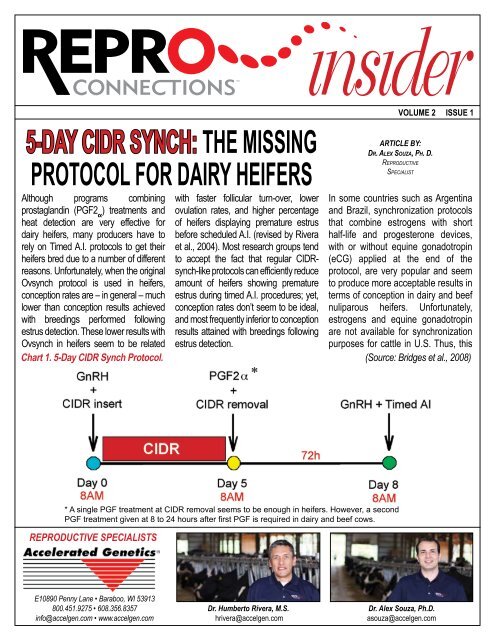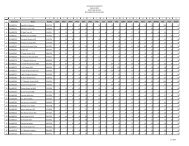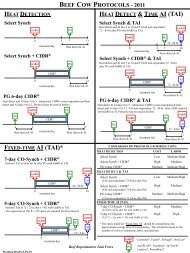5-day cidr synch: the missing protocol for dairy heifers - Accelerated ...
5-day cidr synch: the missing protocol for dairy heifers - Accelerated ...
5-day cidr synch: the missing protocol for dairy heifers - Accelerated ...
You also want an ePaper? Increase the reach of your titles
YUMPU automatically turns print PDFs into web optimized ePapers that Google loves.
insiderTable 1. Type of CIDR treatment and fertility of beef cows.CR (%)article will try to present some insightabout recent and promising findingstowards developing an efficient<strong>synch</strong>ronization program <strong>for</strong> <strong>heifers</strong>utilizing hormones that are availablein <strong>the</strong> U.S. market.Currently, one of <strong>the</strong> best <strong>protocol</strong>s<strong>for</strong> <strong>dairy</strong> <strong>heifers</strong> in terms of conceptionseems to be <strong>the</strong> newly developed5-Day CIDR Synch (Bridges etal., 2008). This is <strong>the</strong> sequence ofinjection during <strong>the</strong> 5-Day CIDR<strong>protocol</strong>: on Day 0, CIDR is appliedtoge<strong>the</strong>r with a GnRH injection. Five<strong>day</strong>s later (5 complete <strong>day</strong>s afterCIDR insertion!), CIDR is removedand a PGF2 αtreatment is given at<strong>the</strong> same time. A second PGF2 αisrequired in beef and <strong>dairy</strong> cows (butnot on <strong>heifers</strong>), sometime between8 to 24 hours after CIDR removal.Then, three <strong>day</strong>s after CIDR removalExperimental Groups(Source: Adapted from Bridges et al., 2008; Exp. 4)(Day 8), animals are bred toge<strong>the</strong>rwith an additional GnRH treatmentat <strong>the</strong> time of A.I.The original work to develop <strong>the</strong>5-Day CIDR <strong>protocol</strong> was done byBridges et al. (2008) using beefcows as experimental units. Theirresults suggested that reducingCIDR insertion from 7 to 5 <strong>day</strong>s,associated with longer pro-estrusintervals improved conceptionrates. It is important to highlightthat Bridges et al. (2008) used twoPGF2 αinjections in all trials toenhance CL regression, <strong>the</strong> firstPGF2 αwas done at CIDR removaland <strong>the</strong> second PGF2 αwas given12 hours later.This pioneer work was done by Bridgeset al (2008) and served as rationale<strong>for</strong> several fur<strong>the</strong>r trials using beef(Kasimanickam, et al., 2009), <strong>dairy</strong>cows (Chebel et al., 2009), and <strong>dairy</strong><strong>heifers</strong> (preliminary results shownby Dr. Thatcher at DCRC meeting –Minneapolis, MN 2009). In addition, anumber of o<strong>the</strong>r ongoing experimentsare to be published in <strong>the</strong> next coupleof months, and <strong>the</strong>y will provide moreknowledge about <strong>the</strong> use and efficacyof <strong>the</strong> 5-Day CIDR <strong>protocol</strong>.For instance, Kasimanickam et al.(2009) tested whe<strong>the</strong>r two PGF2 αtreatments are actually needed atCIDR removal when a 5-Day <strong>protocol</strong>is used in beef cows. Secondarily, inthis same trial, <strong>the</strong>y compared twotypes of PGF products (dinoprostvs cloprostenol) when a single PGFtreatment was given at CIDR removal.In summary, <strong>the</strong>y found no differencebetween <strong>the</strong> two PGF2 αproducts.However, two PGF2 αtreatmentsseem to be necessary <strong>for</strong> maximumconception rates in beef cowsreceiving <strong>the</strong> 5-Day CIDR <strong>protocol</strong>.Finally, <strong>the</strong>re is sufficient scientificevidence proving <strong>the</strong> effectivenessof <strong>the</strong> 5-Day CIDR <strong>protocol</strong> in<strong>dairy</strong> <strong>heifers</strong> (data summarizedand presented by Dr. Thatcher atDCRC meeting in Minneapolis, MN– 2009). Briefly, <strong>the</strong>se researchersobserved in a series of field trialsthat a single PGF2 αtreatmentgiven at CIDR removal is enough toproduce good CL regression, andoutstanding conception results thatare comparable to conception resultsachieved when <strong>heifers</strong> are bred afterregular estrus detection.Dr. Thatcher also reported similarconception rates in <strong>heifers</strong> treated
insiderTable 2. Type A & D Single vs. Double PGF in Beef Cows.Table 3. Effect of One vs. Two PGF in Dairy Heifers.CR (%)CR (%)Experimental Groups(Source: Adapted from Kasimanickam et al., 2008)with new (59.7%) vs 5-<strong>day</strong> usedCIDRs (61.2%). Obviously, correcthandling, sanitization, and evenautoclaving are important detailswhen re-utilizing CIDRs, mostly, toavoid horizontal spread of infectiousdiseases within <strong>the</strong> herd.The new 5-Day CIDR Synch mightalso be a good option <strong>for</strong> those whowant to use sexed semen associatedwith Timed A.I. in <strong>heifers</strong>. In fact,according to later findings (DCRC2009), <strong>the</strong> 5-Day CIDR <strong>protocol</strong>produced acceptable conceptionresults even after <strong>the</strong> use of sexedsemen in <strong>heifers</strong>. For example, in oneof <strong>the</strong> trials that <strong>the</strong>y used <strong>the</strong> 5-DayCIDR <strong>protocol</strong> with a single PGF2 αat CIDR removal, <strong>the</strong>y found thatconception rates <strong>for</strong> <strong>dairy</strong> <strong>heifers</strong> bredwith sexed semen was 43% (43/100)compared to 53.1% (52/98) <strong>for</strong> <strong>heifers</strong>inseminated with regular semen. Thus,conception results with sexed semenin <strong>heifers</strong> treated with <strong>the</strong> 5-Day CIDRSynch are in <strong>the</strong> same range of <strong>the</strong>results achieved when sexed semenis used after estrus detection, butfur<strong>the</strong>r trials are necessary to confirm<strong>the</strong>se encouraging findings.In Summary, here are some of <strong>the</strong>advantages of <strong>the</strong> 5-Day CIDR Synchprogram:1) No pre-<strong>synch</strong>ronization is needed2) Minimum amount of handlings– very simple to apply.Experimental Groups(Source: Adapted from Thatcher et al., 2009 - DCRC)3) Consistent conception results andcomparable fertility to heat detectionbreedings, even in <strong>heifers</strong>.
insider4) The entire <strong>protocol</strong> lasts only 8<strong>day</strong>s, which makes it an attractiveoption <strong>for</strong> re-<strong>synch</strong> breedings <strong>for</strong><strong>heifers</strong>, as well as <strong>for</strong> beef and <strong>dairy</strong>cows (future research needs tovalidate this <strong>for</strong> <strong>dairy</strong> cows).5) 5-Day CIDR <strong>synch</strong> providesacceptable results following sexedsemen breedings in <strong>heifers</strong>.REFERENCES:Decreasing <strong>the</strong> interval between<strong>the</strong> GnRH and PGF2 αfrom 7 to 5 dand leng<strong>the</strong>ning proestrus increasestimed-AI PR in beef cows. Bridgeset al., 2008. Theriogenology 69:843-851.Effect of reducing <strong>the</strong> period of follicledominance in a timed AI <strong>protocol</strong> onreproduction of <strong>dairy</strong> cows. Chebel.,et al. 2009. Proceedings ADSA-ASAS;pg. 250-251; Indianapolis, IN.Two doses of prostaglandin improvepregnancy rates to timed-AI in a 5-dprogesterone-based <strong>synch</strong>ronization<strong>protocol</strong> in beef cows. Kasimanickamet al., 2009. Theriogenology 71:762-767.Timed AI programs in <strong>dairy</strong> <strong>heifers</strong>.Thatcher et al., 2009. ProceedingsDCRC; pg. 57-70; Minneapolis, MN.Fertility of Holstein <strong>dairy</strong> <strong>heifers</strong> after<strong>synch</strong>ronization of ovulation and timedAI or AI after removed tail chalk. Riveraet al., 2004. J. Dairy Sci. 87:2051-2061.<strong>Accelerated</strong> Genetics • 800.451.9275 • 608.356.8357 • info@accelgen.com • www.accelgen.comPRSRT STDU.S. POSTAGEPAIDMADISON, WIPERMIT NO. 1949E10890 Penny Lane. Baraboo, WI 53913-9408Address Service Requestedinsider












